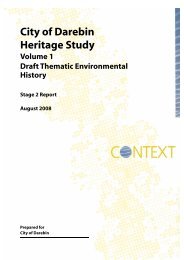How to build a cat enclosure - City of Tea Tree Gully
How to build a cat enclosure - City of Tea Tree Gully
How to build a cat enclosure - City of Tea Tree Gully
You also want an ePaper? Increase the reach of your titles
YUMPU automatically turns print PDFs into web optimized ePapers that Google loves.
9Step 6 – Finishing the timber structureRemember that treated pine is not an option so you will need <strong>to</strong> seal the timber <strong>to</strong>protect it from weathering with a good quality exterior finish. Paint the internal faces <strong>of</strong>the joints before assembly.Step 7 – Ro<strong>of</strong>ing/weather pro<strong>of</strong> claddingNote that in some cases it may be a legal requirement that a licensed plumber isrequired <strong>to</strong> fit the ro<strong>of</strong>ing and flashing (contact your local water supplier for details).Corrugated steel productsZincalume and Colourbond sheeting can be used for ro<strong>of</strong> and partial wall cladding.If you live by the coast then specify corrosion resistant steel sheeting. These productsare easily fixed, however the structure must be sound. They are weatherpro<strong>of</strong> andpermanent but do restrict natural light, which is a consideration when enclosing anexternal wall containing windows. In this situation, clear polycarbonate sheeting such asLaserlight and Suntuff is an ideal solution. There is a wide range <strong>of</strong> grades available,which have differing light and heat transmission characteristics. Each product comeswith specific fixing instructions, which must be followed. Remember that some part <strong>of</strong>the <strong>enclosure</strong> must provide <strong>cat</strong>s with access <strong>to</strong> sunshine, while other areas must giveshelter from the sun.If you are likely <strong>to</strong> climb on polycarbonate ro<strong>of</strong> cladding, you may wish <strong>to</strong> install a safetybarrier directly underneath the material <strong>to</strong> prevent accidental falls. Ask your supplier <strong>to</strong>recommend a light wire mesh that can be fixed on <strong>to</strong>p <strong>of</strong> the battens. The sheeting andend flashing is then fixed <strong>to</strong> the battens with self-tapping Tec screws and rubber washers.You may want <strong>to</strong> consider installing guttering and a downpipe, if excess water run-<strong>of</strong>ffrom the <strong>enclosure</strong> ro<strong>of</strong> is a problem. The gutter should be fixed just below the line <strong>of</strong> thero<strong>of</strong>ing, across the outside <strong>of</strong> the end beam. Remember <strong>to</strong> allow for a second fall, sorainwater can run along a slight slope in the gutter and flow in<strong>to</strong> the downpipe. The pipeneeds <strong>to</strong> be attached <strong>to</strong> the nearest s<strong>to</strong>rmwater outlet. Seek advice from your localhardware s<strong>to</strong>re, or contact a qualified plumber if you need assistance with installing agutter and downpipe.Step 8 – Wall Cladding options– Galvanised welded mesh is rustpro<strong>of</strong> and available in a wide range <strong>of</strong> sizes and gauges.The maximum mesh size recommended for <strong>cat</strong> <strong>enclosure</strong>s is 50 x 50 mm. A well-fixed4-gauge mesh will provide reasonable security for your <strong>enclosure</strong> and is strong enough<strong>to</strong> support climbing plants should you wish <strong>to</strong> add them. Metal mesh is fixed <strong>to</strong> thetimber posts and timber rails with staples or washers and Tec screws depending onmesh sizes and loading. See Figure 6. Light flexible mesh is held in position with atimber batten nailed <strong>to</strong> posts or your existing structure (eg house or fence). Ask yourmesh supplier <strong>to</strong> advise on the optimum fixing method for your appli<strong>cat</strong>ion.– Lightweight 25 x 25 mm mesh makes a good barrier where security is not aconsideration. The mesh can be fixed with washers and Tec screws.– Galvanised chicken wire is a cheap alternative and is fixed with battens anchored <strong>to</strong>the base structure.– Shade cloth is available in a wide range <strong>of</strong> colours and opacities making it a goodoption for your <strong>enclosure</strong>. It has good UV stability and will last for years, however itshould be checked occasionally for signs <strong>of</strong> weakness. It is fixed <strong>to</strong> the structure withspecial fasteners that are available from your shade cloth supplier. Shadecloth wallsare prone <strong>to</strong> damage from climbing <strong>cat</strong>s and can be strengthened with metal mesh.Remember that some part <strong>of</strong> the <strong>enclosure</strong> must provide <strong>cat</strong>s with access <strong>to</strong>sunshine, while other areas must give shelter from the sun.– Insect screening can be incorporated in<strong>to</strong> the structure but it needs <strong>to</strong> be supportedby a stronger mesh.– Commercial netting products. Any netting is suitable provided it is strong, UV stableand rot resistant. Access doors can be sewn in with a zip fastener. See supplier list,(appendix 1).Please Note: If netting is <strong>to</strong> be used <strong>to</strong> clad the <strong>enclosure</strong> then a wooden board needs<strong>to</strong> be set in<strong>to</strong> the ground around the perimeter <strong>of</strong> the <strong>enclosure</strong>.PostsideviewGalvanisedboltTop PlateHousing DetailFigure 3: Top plate housingHeader4AAdditionaluprightCross Bracing andPost <strong>to</strong> Top PlateFigure 4A: Fixing method for timberFigure 4B: Fixing method for galvanised steel tubingFigure 5: Door detailBrace and Rail DoorWall4BHingeside

















